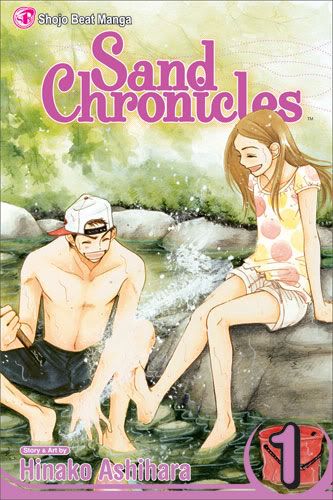Earlier in the year I reviewed the first volume of Sand Chronicles after finding it at my local library and I said that I would like to read the rest of the series. As it turns out, the local library near my college has volumes one through nine which is almost the complete series. Technically the main story ends in volume eight, making nine and ten just a collection of short stories, so I feel confident that the last volume wouldn't drasticaly change my opinion on the story so I'm treating this as a review of the entire series.
Sand Chronicles by Hinako Ashihara
Summary: Ann's parents split up when she was 12 and shortly after her mother committed suicide which affects her for the rest of the series. During the break up, she and her mother move to her mother's old hometown where Anne meets Diago, a local boy, and Fuji and Shika (siblings from a local rich family) and the four of them grow close. But when Anne's father finds her again she goes back to Tokyo for high school and reconnects with her old life while trying to retain the friendships and romances she built up away from home, all the while trying to figure out who she does love.
The Good: Most shojo manga only cover a very short period of time, almost always when the heroine is in high school, but Sand Chronicles follows Anne from when she's 12 to when she's 26 which is very nice (even if there is a large time skip from when she's 18 or 20 to when she's 26). In the earlier years it's great to see Anne slowly get over her mother's death, begin to move on, and feel confident enough to start dating Diago. The fact that Anne's dad came back and was genuinely a nice guy was a pleasant surprise as well* as well as the other developments in that subplot.
The Bad: Sadly, the series doesn't hit quite the same notes that it did in the first volume. A lot of it is Anne wallowing around and wondering if she made the right choices in romance (and, since it's shojo, any casual romance she doesn't over think ends badly, so being unreasonably finicky is better than being happy until you find true love?). The side characters in this story are a bit flat, they seem to exist so that the reader can compare their situation to Anne's or for them to give Anne friendly advice, not as three dimenstional characters with their own lives. And, once Shika goes abroad and Anne and Fuji break up, both of them drop out of the story as well. Yes this is Anne's story in the end but characters don't exist in a vacuum, I really wish Ashihara had made a greater effort to have more central characters.
The Art: While the art looks different from the other shojo titles Viz publishes (they seem to go for a wide range of art styles in their shonen and shojo titles actually) it's still nothing especially different or strange in the slightest. It tells the story, the panels aren't too confusing to follow (generally anyway), I just don't feel the urge to get an artbook with pictures from the series.
In the end, I liked the earlier volumes more than the later ones but for a shojo romance it's not bad at all. If I come across volume 10 I'll be sure to read it but right now I'm not sure if I want to buy the series. It was nice at parts, I wanted to beat my head against the wall at others and I'm just not sure if this holds a lot of re-read value for me as a result. But I certainly recommend it to shojo lovers, there's no reason to not at least check it out.
*I've often wondered why stories have to make divorce the fault of one of the parents instead of both or neither, Sand Chronicles shows that it is Anne's father's fault for getting into debt but he does work it off and really did care about his wife and daughter. I liked that touch a lot and it managed to feel both more idealized and realistic than how many other books handle the issue.
